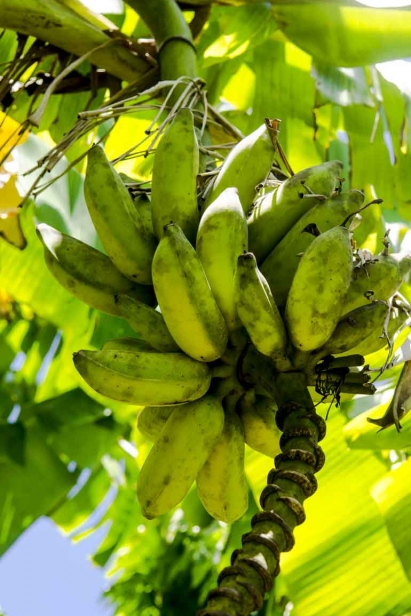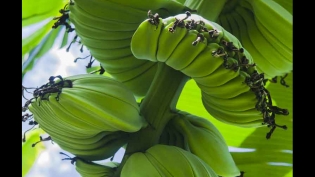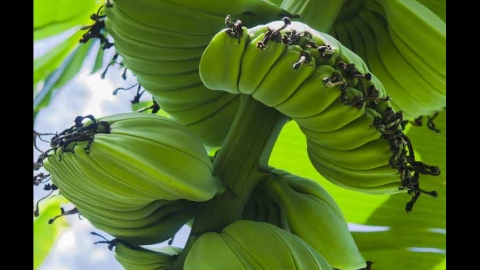Know Your Bananas
Native to Southeast Asia, bananas and plantains have been cultivated for thousands of years. Most banana cultivars are hybrids of Musa acuminata and M. balbisiana. The banana is not a tree, but an herb, with a trunk-like pseudostem, made of tightly overlapping leaves. Its underground rhizome (corm), has fibrous roots underneath. The flowering stalk contains the fruit, technically a berry. Multiple “hands” of 10-20 bananas grow upward, making up a raceme, and ripen from the top down. Bananas are monocarpic – they flower once, then die. Meanwhile, shoots called “suckers” emerge from the parent plant to form a new plant. Commercial growers propagate bananas by tissue culture, the process of cloning tissues of quality plants in a lab. Multiple, disease-free seedlings are started, then raised in nursery beds.
Bananas and Plantains
Both are a good source of ascorbic acid (vitamin C), vitamin B6 and potassium. Plantains also have vitamin A and are an excellent source of starch. Ripe bananas are sweet and delicious to eat out of hand, while plantains have a high starch content and are less sweet. Bananas can be eaten raw or cooked, while plantains must be cooked before eating. Consider green plantains like potatoes, ready to be boiled, steamed, roasted or fried and turned into tostones. As they ripen and turn yellow or black (maduros), they get sweeter, and can be baked, sauteed and grilled.
Nearly all parts of the banana are used. The banana flower shows up in Asian dishes, chopped and cooked in curries and added fresh to salads. Banana leaves are used to wrap hallacas and tamales and whole fish. In India and Malaysia, a whole banana leaf serves as a plate for scoops of rice, curry and condiments. In Hawaii, banana leaves line underground pits to cook pigs. Banana leaves bring tropical beauty to table settings, perfect for lining plates and platters.
Six Top Bananas
Bananas are relatively easy to grow, especially compared to mango, avocado or other fruit trees. After planting a banana, you can eat fruit in about 16 months. If there’s a hurricane, they’ll come back. Don Chafin recommends these varieties for flavor and ease in growing.
Namwa
Also known as Pisang awak, these ladyfinger bananas – large bunches of sweet fruit – have a shelf life of 10-12 days.
Pisang raja
This full-size Indian variety has sweet, yellow-orange flesh.
Raja puri
Fat, three-quarters-sized fruits are cool tolerant, grow quickly.
Ice cream
These popular, cool-tolerant plants produce blue/green fruit with pure white, sweet, creamy flesh that tastes like vanilla ice cream.
Goldfinger
Fast-growing and disease-resistant, these plants ripen quickly and grow to about 10-12 feet.
Red
Known for their gorgeous colors, these very sweet ladyfinger bananas ripen from dark burgundy to orange and yellow-green.











